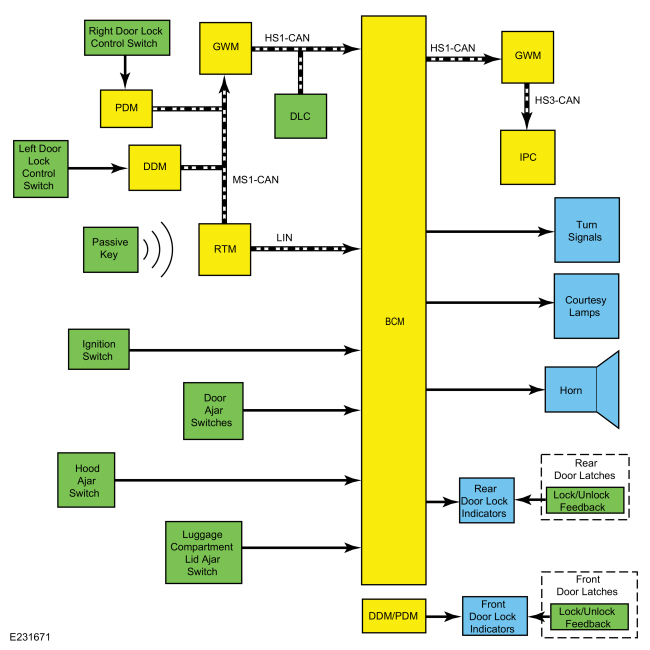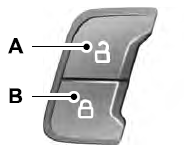Ford Fusion: Perimeter Anti-Theft Alarm / Perimeter Anti-Theft Alarm - System Operation and Component Description. Description and Operation
System Operation
System Diagram

| Item | Description |
|---|---|
| 1 | BCM |
| 2 | Turn Signals |
| 3 | Horn |
| 4 | Door Ajar Switches |
| 5 | Hood Ajar Switch |
| 6 | Luggage Compartment Lid Ajar Switch |
| 7 | Right Door Lock Control Switch |
| 8 | IPC |
| 9 | Courtesy Lamps |
| 10 | Passive Key |
| 11 | RTM |
| 12 | Ignition Switch |
| 13 | DDM |
| 14 | GWM |
| 15 | GWM |
| 16 | PDM |
| 17 | Left Door Lock Control Switch |
| 18 | DDM/PDM |
| 19 | Front Door Lock Indicators |
| 20 | Lock/Unlock Feedback |
| 21 | Rear Door Latches |
| 22 | Rear Door Lock Indicators |
| 23 | Lock/Unlock Feedback |
| 24 | Front Door Latches |
| 25 | DLC |
Network Message Chart
IPC Network Input Messages
| Broadcast Message | Originating Module | Message Purpose |
|---|---|---|
| Perimeter alarm chime request | BCM | Used by the IPC to sound the perimeter alarm chime during the 12-second delay. |
BCM Network Input Messages
| Broadcast Message | Originating Module | Message Purpose |
|---|---|---|
| RKE data | RTM | Used by the BCM to arm/disarm the perimeter alarm or to activate/deactivate the panic alarm. |
| Door lock switch status | DDM | Used by the BCM to arm/disarm the perimeter alarm. |
Anti-Theft - Perimeter
Perimeter Alarm
The BCM controls the operation of the perimeter alarm. It monitors inputs from the RKE system, the passive entry system (if equipped), the power door lock system, the PATS and the ignition status to determine when to arm the perimeter alarm.
The BCM monitors all of the door ajar switches, the luggage compartment lid ajar input, the hood ajar switch, the CAN and the ignition status to determine when to activate the perimeter alarm. When the BCM detects an input indicating an unauthorized entry into the vehicle, the BCM activates the perimeter alarm by sounding the horn and flashing all the turn signals and interior courtesy lamps at regular intervals.
The BCM monitors the RKE system, the passive entry system (if equipped), and the PATS to determine when to disarm the perimeter alarm.
A
switch inhibit feature temporarily disables the door lock control
switches and the interior luggage compartment lid release switch 20
seconds after the vehicle is electronically locked. For detailed
information of the switch inhibit feature,
Refer to: Handles, Locks, Latches and Entry Systems - System Operation and Component Description (501-14 Handles, Locks, Latches and Entry Systems, Description and Operation).
Additionally, there is a door lock LED
indicator located on each door window sill. The indicators provide
lock/unlock indication for each door. They illuminate when the door is
locked and are off when the door is unlocked. For detailed information
of the door lock LED indicators,
Refer to: Handles, Locks, Latches and Entry Systems - System Operation and Component Description (501-14 Handles, Locks, Latches and Entry Systems, Description and Operation).
Visual
and audible feedback is also provided when locking or unlocking the
vehicle. For detailed information of the vehicle locking and unlocking
feedback,
Refer to: Handles, Locks, Latches and Entry Systems - System Operation and Component Description (501-14 Handles, Locks, Latches and Entry Systems, Description and Operation).
Arming The Perimeter Alarm
The perimeter alarm is ready to arm any time the ignition is off. The perimeter alarm pre-arms when any of the following actions are performed:
- Pressing the lock button on a RKE transmitter
- Pressing the door lock control switch to the lock position with a front door open, and then closing the door
- Touching the 7/8 and 9/0 buttons simultaneously on the keyless entry keypad (if equipped)
- Locking the vehicle with the passive entry feature (if equipped)
Once the system is pre-armed, there is a 20-second countdown before the perimeter alarm is armed. Each entry point to the vehicle (hood, door and luggage compartment lid) is armed separately and must be closed before that entry point begins the 20-second countdown to become armed. If all entry points are closed, the turn signals flash upon locking indicating that all entry points are entering the 20-second countdown.
Perimeter Alarm Activation
The perimeter alarm has a 12-second delay when the driver front door is opened without using a RKE transmitter, the keyless entry keypad (if equipped) or a passive key (if equipped) to unlock the vehicle. During the delay, a chime sounds. If the perimeter alarm is not disarmed within the 12-second delay, the alarm activates.
The perimeter alarm activates when any of the following actions are performed:
- The driver front door is opened without first receiving an unlock command from the passive entry feature (if equipped), the keyless entry keypad (if equipped) or a programmed RKE transmitter, and the 12-second delay has expired.
- Any other door, the luggage compartment lid, or the hood is opened without first receiving an electronic unlock command from the passive entry feature (if equipped), the keyless entry keypad (if equipped) or a programmed RKE transmitter.
- the BCM detects an attempt by a diagnostic scan tool to establish communication on the CAN.
The perimeter alarm only activates 10 times per arming cycle. After that, the alarm does not activate. To enable the perimeter alarm again, disarm the perimeter alarm and then arm it again.
Disarming The Perimeter Alarm
The perimeter alarm disarms when any of the following actions are performed:
- Pressing the unlock button on a door lock control switch within the 20-second pre-arm
- The smart unlock feature activates within the initial 20-second pre-arm
- Pressing the unlock button on a programmed RKE transmitter
- Pressing the luggage compartment lid release button on a programmed RKE transmitter (this only inhibits the luggage compartment entry point with the rest of the vehicle remaining armed)
- Using a programmed key to change the ignition to RUN
- Entering the correct vehicle unlock code on the keyless entry keypad (if equipped)
- Unlocking a front door or the luggage compartment lid using the passive entry feature (if equipped)
CAN Protection Strategy
When the perimeter alarm is armed, the BCM monitors the CAN. If a scan tool is connected to the DLC, and an attempt is made to establish a session with the BCM, it activates the perimeter alarm.
Every time the BCM detects an unauthorized access (alarm activates), all BCM programming, PID monitoring and self-test sessions are blocked for 10 minutes. At the end of the 10 minute time period, the traffic horn chirps to indicate the 1 minute of opportunity to communicate with the BCM and program keys if none are available.
Refer to: Anti-Theft Key Programming - Scan Tool (419-01B Passive Anti-Theft System (PATS), General Procedures).
Component Description
Door Latch
The door ajar switch, the lock/unlock solenoid and the lock/unlock status input switch are part of the door latch and not serviceable separately.
The door ajar switch is monitored by the BCM and the primary function is for the courtesy lamps system.
Refer to: Interior Lighting (417-02)
.
The lock/unlock solenoid is controlled by the BCM for locking and unlocking the door.
Refer to: Handles, Locks, Latches and Entry Systems - System Operation and Component Description (501-14 Handles, Locks, Latches and Entry Systems, Description and Operation).
The lock/unlock status input switch is used to illuminate the door lock status indicator.
Refer to: Handles, Locks, Latches and Entry Systems - System Operation and Component Description (501-14 Handles, Locks, Latches and Entry Systems, Description and Operation).
Hood Ajar Switch
The hood ajar switch is a single pole switch (integrated into the hood latch) that is normally closed when the hood is closed. When the hood is opened, the hood ajar switch opens to indicate an open hood.
The BCM sends a signal to the hood ajar switch and, based on the input, determines if the hood is open or closed.
BCM
The BCM controls the operation of the perimeter alarm. Based on input, the BCM arms, disarms, activates or deactivates the perimeter alarm.
The BCM requires PMI when replaced. Additionally, at least 2 keys must be programmed and the parameter reset procedure carried out.
 Perimeter Anti-Theft Alarm - Overview. Description and Operation
Perimeter Anti-Theft Alarm - Overview. Description and Operation
Overview
The
perimeter alarm system deters unauthorized entry into the vehicle by
sounding the horn and flashing all the turn signals and interior
courtesy lamps...
 Perimeter Anti-Theft Alarm. Diagnosis and Testing
Perimeter Anti-Theft Alarm. Diagnosis and Testing
BCM
DTC Chart
Diagnostics in this manual assume a certain skill level and knowledge of Ford-specific diagnostic practices. REFER to: Diagnostic Methods (100-00 General Information, Description and Operation)...
Other information:
Ford Fusion 2013–2020 Owners Manual: Unique Driving Characteristics (If Equipped)
The system helps reduce fuel consumption by automatically shutting off and restarting the engine while your vehicle is stopped. The engine will restart automatically when you release the brake pedal. In some situations, your vehicle may restart automatically, for example: To maintain interior comfort To recharge the battery Note: Power assist steering is turned off when the engine is of..
Ford Fusion 2013–2020 Service Manual: Turn Signal and Hazard Lamps. Diagnosis and Testing
DTC Chart: BCM Diagnostics in this manual assume a certain skill level and knowledge of Ford-specific diagnostic practices. REFER to: Diagnostic Methods (100-00 General Information, Description and Operation). BCM DTC Chart DTC Description Action B123A:11 Left Front Turn Indicator: Circuit Short to Ground For halo..
Categories
- Manuals Home
- 2nd Generation Ford Fusion Owners Manual
- 2nd Generation Ford Fusion Service Manual
- Transmission - 1.5L EcoBoost (118kW/160PS) – I4. Removal and Installation
- Body Control Module (BCM). Removal and Installation
- Engine - 1.5L EcoBoost (118kW/160PS) – I4
- New on site
- Most important about car
Power Door Locks
The power door lock control is on the driver and front passenger door panels.


.jpg)